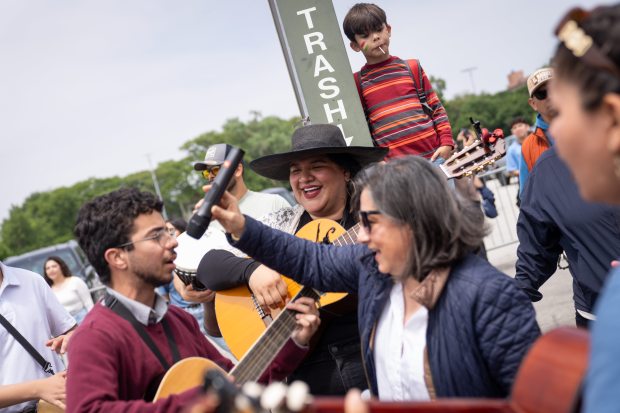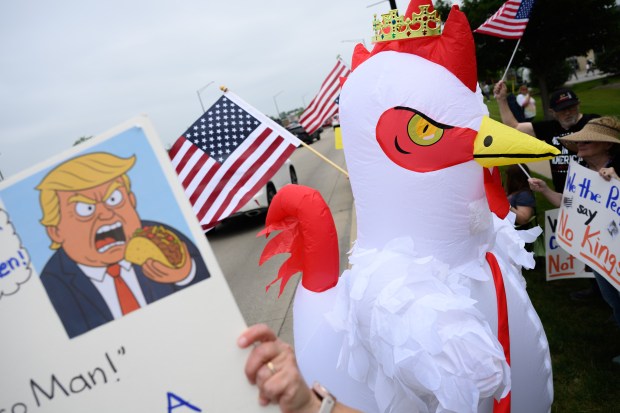There’s a moment in a dancer’s career in which everything changes. For Morgan Clune of Hubbard Street Dance Chicago, it was last night. Clune subbed in for Hubbard Street veteran Jacqueline Burnett to dance the lead role in founding artistic director Lou Conte’s signature work, “Georgia.”
“Georgia” is the cherry on top of a decadent program — the first of two in Hubbard Street’s two-week winter pilgrimage to the Edlis Neeson Theater at the Museum of Contemporary Art.
The Neeson is such a different experience as an audience member with just a fifth of the capacity of the Harris Theater, Hubbard Street’s home for the rest of the year. It’s worth pointing this out. To be sure, the Harris is a fantastic venue, but Chicago dance desperately needs a high-quality downtown option with, say, 750 seats for just-right accommodations, to catalyze a jump to the Harris. In this case, every seat at the Neeson was sold before opening night.
And for good reason. The close-up vantage point and unparalleled sightlines make the Neeson one of this critic’s favorite places for dance, though its presence there has waned to almost nothing in recent years. From those 300 seats, you can see Clune’s metatarsal bones in her foot — that’s how close it is — as she sits into her left hip, her right foot pricked up into a perfect point against a bent knee giving shape to a wispy, pink slip dress. You can see the sculptural S-curve of her arms revealing the musculature of the back. Few Hubbard Street dancers have had opportunities to express that moment on stage, which so indelibly captures Hubbard Street’s origin story. Clune is also the first of a generation to perform this work without learning directly from Claire Bataille, Conte’s muse who originated the role and who died in 2018. And she nailed it.
If “Georgia” represents the past, the three other works on Friday’s program — and those to come in a separate bill next weekend — are firmly rooted in Hubbard Street’s present and future.
Resident choreographer Aszure Barton offers the first brand-new work of her three-year engagement with Hubbard Street, a duo (literally called “A Duo”) for dancers Aaron Choate and Abdiel Figueroa Reyes and set to music by Marina Herlop. Pitchfork magazine described the Catalan composer as “classically trained and totally chaotic” — a description of “A Duo” I suspect Barton might appreciate.
Barton selected two tracks exemplifying Herlop’s recent foray into South Asian Carnatic music, underpinning electronic scores with multi-syllabic talas. To this accompaniment is a similar pastiche, the dance appropriating elements from vogue and Bharatanatyam with the occasional Michael Jackson crotch grab. There is perhaps something subversive here about paradoxically revered and subjugated subcultures that ties these seemingly disparate elements together — maybe. And it’s all shoved in literal boxes, thanks to crisp, geometric lighting from Nicole Pearce relegating Choate and Figueroa Reyes to their respective sides of the stage.
That is, until near the end, when this duo becomes a duet. In that physical manifestation of a tongue twister, one can’t help but see echoes of post-modernism — Choate’s wavy ponytail almost resembles the signature long braid of Nancy Stark Smith. Smith and Steve Paxton, who died this week, are credited with developing contact improvisation (Smith died in 2020). So they’re on my mind, as part of a wave of artistic ingenuity in the 1960s and ‘70s that some critics feel has not and will never be surpassed. But with Barton and Hubbard Street, whatever comes next is happening, and it’s happening here. Up to now, we’ve only seen re-stagings of Barton’s prior works, a testament to her unparalleled talent, yes, but it’s not until now we see what relatively unfettered access to play with this city’s best dancers can produce. With “A Duo,” the result is exhilarating and mildly offensive — as dance should be to move it somewhere new.
Bookending the program, collectively titled “Of Hope,” are repeats of Randy Duncan’s “Love Infinite” and “Dear Frankie,” the latter an exquisite offering by Rennie Harris detailing the origins of Chicago-style house music that’s only getting better each time Hubbard Street does it. I didn’t think I wanted or needed to see “Love Infinite” again — it’s an unspoken truth that if you’ve seen one of Randy Duncan’s works, you’ve kind of seen them all. But that might be because they’re rarely performed more than once. Duncan’s professional catalog consists almost entirely of closing numbers created for the Dance for Life benefit.
Repeat viewings and time marinating in the dancers’ bodies reveal nuances and details that make a “Randy closer” (seen here at the beginning of the night) so spectacular — even if it does feel a bit like sitting inside a disco ball. But who doesn’t love a disco ball? And the message is crystal clear, enshrined by those twirling dancers and lyrics by Ira Antelis that accompany them: “We all need some love.”
Review: Hubbard Street Dance Chicago presents “Of Hope” (4 stars)
When: Through March 3
Where: Edlis Neeson Theater at the Museum of Contemporary Art Chicago, 220 E. Chicago Ave.
Running time: 90 minutes with intermission
Tickets: Sold out; limited $35 standby tickets will be available; www.hubbardstreetdance.com





